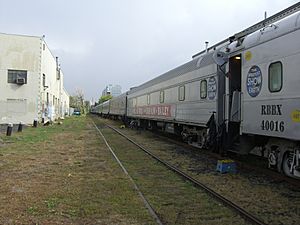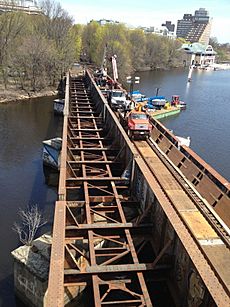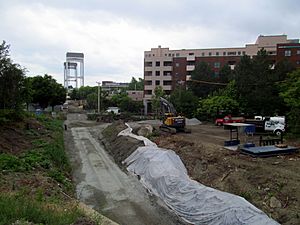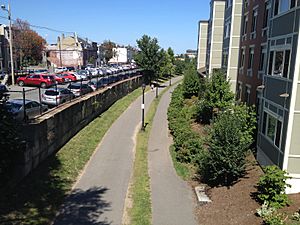Grand Junction Railroad facts for kids
Quick facts for kids Grand Junction Railroad |
|
|---|---|
| Overview | |
| Locale | Boston, Massachusetts |
| Termini | East Boston Terminal |
| Technical | |
| Line length | 8.55 mi (13.76 km) |
| Track gauge | 4 ft 8 1⁄2 in (1,435 mm) |
| Loading gauge | Minimal Plate B |
The Grand Junction Railroad is a train line in Boston, Massachusetts. It is about 8.5 miles (13.7 km) long. This railroad connects other train lines that go west and north from Boston. A very famous part of this line is its railroad bridge over the Charles River. This bridge goes right under the Boston University Bridge!
Today, most of the railroad is still used. It carries scrap metal to and from a yard in Everett. It also moves freight to the Chelsea Produce Market. Important for passengers, it helps move Amtrak and MBTA passenger trains. This allows trains to switch between North Station and South Station in Boston.
Contents
History of the Grand Junction Railroad
The Grand Junction Railroad was officially started on April 24, 1847. Its full name was the Grand Junction Railroad and Depot Company. The goal was to connect train lines coming into Boston from the north and west with its docks in East Boston. Before this, it was called the Chelsea Branch Railroad, which began in 1846.
First Sections Open
The first part of the railroad opened in 1849. This section went from East Boston to the Boston and Maine Railroad in Somerville. It started at a huge train yard near Boston Harbor. The line had at least two tracks and ran north. In 1905, the Grand Junction Railroad in East Boston was rebuilt. It became a two-track line that ran below ground level.
In March 1852, the Eastern Railroad leased part of the line. This allowed Eastern Railroad trains to reach downtown Boston. They built a new connection in 1854 to use the Grand Junction line.
Completing the Line
The rest of the Grand Junction line was finished in 1856. It connected to the Boston and Worcester Railroad in Allston, which is now part of Boston. Instead of joining the Fitchburg Railroad, it ran alongside it for a bit. Then it turned south, crossing the Fitchburg Railroad into Cambridge.
In 1862, the line was renamed the East Boston Freight Railroad. Later, in 1869, the Boston and Albany Railroad bought it. Over the years, it became part of bigger companies like the New York Central Railroad, Penn Central, and Conrail.
A bridge over Chelsea Creek broke in 1955 and was never fixed. This meant trains could no longer reach East Boston directly on the Grand Junction. Train service to East Boston ended around 1972.
Western Part of the Railroad
The western part of the Grand Junction Railroad is still very busy! The MBTA uses it to move commuter trains. Amtrak also uses it to move Downeaster trains. This section of the line is owned by MassDOT. However, MIT (Massachusetts Institute of Technology) owns the land for two parts of the line, but allows trains to use it.
Where the Western Line Goes
This part of the Grand Junction line is mostly in Cambridge. Some small parts are in Allston and Somerville.
The line splits off from the old Boston and Worcester Railroad line. Soon after, it crosses the Charles River on the Grand Junction Railroad Bridge. This bridge is special because it goes right under the Boston University Bridge! After the river, the line runs through Cambridge. It follows what used to be the shore of the Charles River. Now, it forms a border between the main campus of MIT and the rest of Cambridge.
Further along, the line connects to other major train lines. This allows freight trains to move between different routes. It then runs through Charlestown (part of Boston) and crosses the Mystic River. It continues through Everett and Chelsea.
Recent History of the Western Line
Until 2018, CSX Transportation ran one freight train daily on this line. It went to the New England Produce Center and scrap yards in Everett. The Barnum and Bailey Circus train also often parked here when the circus was in Boston.
In 2008, the state government made a deal to buy and improve several freight lines from CSX Transportation. This included the western part of the Grand Junction. The deal was completed in 2012.
In late 2012, the Grand Junction Railroad Bridge was in poor condition. Trains had to slow down to 5 mph. Soon after, the bridge was closed to all trains. This meant trains moving between Boston's north and south sides had to take a very long detour. The bridge reopened in early 2013 after emergency repairs. It closed again for more repairs from March to June that year.
The City of Cambridge is looking into building a walking and biking path next to the railroad. It would be called the Grand Junction Community Path.
Future Ideas for the Western Line
There have been ideas to use the Grand Junction for more public transportation. One idea was to add lanes for special buses on the railroad bridge.
Another idea was to extend the Framingham/Worcester Line commuter rail service. This would allow trains from Worcester to go all the way to North Station in Boston. However, in 2011, the state decided not to pursue this idea for now. They chose to focus on expanding South Station instead.
The Grand Junction was also considered as a route for trains carrying ethanol (a fuel additive). These trains would run at night to a tank farm in Revere. But this idea was dropped in 2013 due to strong community opposition.
In 2014, there was a proposal to connect a new West Station to North Station using the western part of the line. This plan also included a new train station in Cambridge.
Eastern Part of the Railroad
The eastern part of the Grand Junction Railroad no longer has trains running on it. But the land has been used for other important things.
Silver Line SL3 Busway
In 2013, MassDOT announced plans to turn a section of the eastern line into a busway for the Silver Line bus service. They also planned a walking and biking path next to it.
In Chelsea, the Silver Line Gateway (SL3 line) busway has been built. This busway uses the old Grand Junction land.
Martin A. Coughlin Bypass Road
The Grand Junction railroad bridge over Chelsea Creek has been removed. A section of the old railroad land was turned into the Martin A. Coughlin Bypass Road. This is a two-lane road for trucks going to and from Logan Airport. It opened in 2012.
Parks and Greenways
Conrail stopped using the line near the East Boston docks in the 1970s. The old train yards were used as a private parking lot for Logan Airport. In 1989, the state began plans to buy this land. It was to become a public park to make up for a park that was destroyed for airport expansion in 1969. After some issues, the land was bought in 2001. In 2007, Bremen Street Park opened on this site.
The remaining southern part of the line was not used. Local people tried to clean up the tracks to make a green space in 1978. In 1997, Conrail gave this section to The Trust for Public Land. After eight years of building, the East Boston Greenway opened in 2007. This is a popular path for walking and biking.
Images for kids
-
The Grand Junction Railroad Bridge crosses the Charles River underneath the Boston University Bridge.







